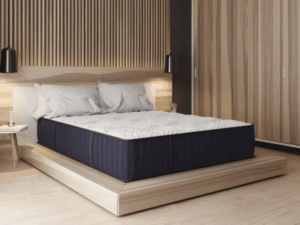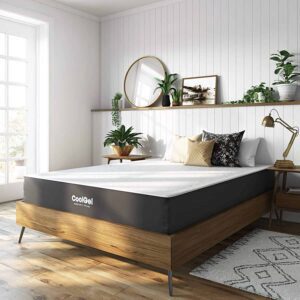How Much Does a Good Mattress Cost?
Disclosure: By clicking on the product links in this article, Mattress Nerd may receive a commission fee at no cost to you, the reader. Read full disclosure statement.
New mattresses today can range in price from less than $200 to $5,000 or more. Some mattress models even cost north of the $10,000 mark. Much like your budget for a home, car, clothes or vacations, your mattress budget depends on your financial situation and unique needs.
In general, most shoppers can find what they’re looking for with a mattress budget of less than $1,500. However, this still doesn’t answer the question: How much should you spend on a new mattress? In this guide, we help you answer that question by sharing the average mattress cost by type, how to determine which mattress is best for you, unforeseen costs associated with buying a new bed and advice on how to save money on a new mattress. After reading, you should be able to confidently determine the right mattress budget for you.

Average Mattress Cost by Type
The type of mattress you select is one of the most impactful factors on its price. Mattresses vary widely in style and the materials used in their construction. Both the construction and quality of the materials can increase or reduce the bed’s final price point.
In the table below, you’ll find the low end, high end, and average costs for various mattress types in a queen size mattress. Keep in mind that some mattress brands may have mattresses priced significantly lower or higher than what we’ve listed here. These are simply the most common price ranges and the average cost you’ll see when shopping around.
| Low End | High End | Average Price | |
| Hybrid | Less than $800 | More than $2,200 | $1,600 |
| Innerspring | Less than $600 | More than $1,200 | $1,000 |
| Foam | Less than $500 | More than $1,500 | $1,000 |
| Latex | Less than $600 | More than $2,500 | $1,200 |
| Airbed | Less than $800 | More than $2,500 | $1,000 |
Cost Factors by Mattress Type
From the table above, you can see that certain mattress types are more expensive than others. What makes hybrids more expensive? Why are innerspring mattresses among the most affordable? Below, we uncover the factors that impact each mattress style’s price tag.
Hybrid
- Hybrid mattresses combine foam comfort layers and a pocketed coil support core. The variety of materials increases the price point.
- Hybrid mattresses are also among the most complex in design. Mattress manufacturers who sell hybrids create them with the intention of combining the best qualities of all-foam and innerspring beds. Creating a mattress that provides the ideal blend of support and pressure relief is costly and time-consuming, making the final product more expensive.
- Hybrids require complex construction. Hybrids incorporate a mix of high-quality comfort layers, specialty foams, micro-coils, and other unique components that other mattresses don’t contain.
Innerspring
- Innerspring mattresses are among the least expensive thanks to the simplicity of their design. However, they’re also among the least durable. Cheap innerspring models have shorter lifespans than average and may only last two to five years.
- Innerspring pricing will vary based on whether the coils inside are pocketed (move independently) or interconnected. Technically, innerspring that contain pocketed coils and thick comfort layers are hybrids, making them more expensive than traditional innerspring beds that contain Bonnell, offset or continuous coils.
- The makeup of the coils, specifically coil count and coil thickness (gauge) can also impact the price. Thicker coils lend themselves to more durability, as does a higher coil count. Still, both of these will impact the mattress’ final price.
Foam
- The type of foam (polyfoam, memory foam, etc.) used in an all-foam mattress will determine the price, as some foams degrade faster than others.
- Some mattresses incorporate specialty foams, like gel- or copper-infused foams, into the comfort and transitional layers to aid in temperature neutrality. The use of specialty foams will increase the product’s price.
- Foam density also impacts pricing. Low-density foams, for example, deteriorate more quickly but are softer to the touch. High-density foams are firm and durable—you’ll typically find them in foam mattresses with high price points.
Latex
- Part of what makes latex mattresses more expensive than all-foam beds is the taxing work required to source and process latex. Latex is derived from the rubber tree and must be converted into foam via the Dunlop or Talalay process.
- Whether the latex used in the mattress was created via the Dunlop or Talalay process will also impact price. Dunlop latex is heavy and dense, whereas Talalay is light and less dense. High-quality latex mattresses typically contain both types.
- Whether natural or synthetic latex is used will greatly affect the bed’s price. Synthetic latex is man-made and has a different feel and firmness than natural latex.
Airbed
- Airbeds feature air pockets in the support core or top layers of the bed. As opposed to simple air mattresses, airbeds can be very expensive.
- Most airbeds feature highly technical designs that incorporate remotes and controls to inflate and deflate the bed on command, precisely tuning it to your body’s sleep style.
- An airbed’s price will rise if high-quality foams, like memory foam or latex, are used in the comfort layers.
What To Consider When Buying a Mattress
Durability / Lifespan
Quality matters greatly when it comes to your mattress purchase. One of the best ways to reduce costs over time is to invest in a mattress that will last five to eight years. This is the length of time most doctors and industry experts recommend keeping a mattress. Here at Mattress Nerd, we recommend researching the most durable mattress brands and styles. Customer reviews, for example, can indicate how long previous buyers’ mattresses have lasted.
Conforming Ability
A mattress’s ability to conform to your body in all the right places depends on its style, manufacturer and comfort layers. Innerspring mattresses, for example, offer very poor conforming power whereas memory foam mattresses and hybrid mattresses usually offer excellent conforming. If you have aches and pains or prefer a mattress with a deep hug around pressure points, this is an important quality to consider. Side sleepers need the most pressure relief around their hips and shoulders, whereas stomach sleepers need a mattress that conforms slightly around the hips without causing them to sink.
Temperature
Do you tend to wake up in a sweat or sleep hot? There’s an ideal temperature range your body needs to maintain to achieve deep sleep, and mattresses can exacerbate overheating issues or relieve them. If you sleep hot, look for a mattress with coils, like that of an innerspring, breathable layers (hybrids excel in this) or infused foams, like copper and gel, to release trapped heat.
Motion Transfer
If you sleep with your partner or pet and wake easily to their movements throughout the night, a bed that minimizes motion transfer and associated noises can improve the quality of your sleep. Mattresses vary widely in their ability to isolate motion, so we recommend reading reviews from trusted websites about this quality prior to your purchase if this is an important factor in your decision.
Additional Costs and Considerations
Shipping
The vast majority of online mattress brands and third-party retailers now ship new mattress purchases for free to the 48 contiguous United States. If you’re located somewhere offshore, like Alaska or Hawaii, it’s likely you’ll be required to pay for a portion of or the entire cost of shipping.
Returns
If you purchase a mattress from a company that allows a sleep trial (most do), you’ll have the option to return the mattress within a 30- to 365-night window, depending on the length of the trial. However, we recommend reading the fine print of the company’s return policy and sleep trial policy, as some hidden fees may be written in. For example, customers may be required to pay for shipping fees for a mattress that’s returned within the sleep trial period. Alternatively, some mattress companies make returns 100% free and coordinate White Glove mattress pickup for you.
White-Glove / Delivery
There’s usually only one problem with buying a new mattress: getting rid of your old one. Some mattress companies offer free White Glove delivery, which can include in-home setup and removal of an old mattress. Other mattress companies will charge a fee for White Glove delivery, which costs roughly $100 on average.
Bed foundations, frames, etc.
If you don’t have a foundation for your bed already, we recommend including the cost of a foundation or frame in your mattress budget. A bed base can consist of a frame, box spring, adjustable base, platform, foundation, or a combination of these.
Box springs tend to be the cheapest type of bed base, but you’ll want a foundation if you prefer a furnished look to your room and if you want space underneath the bed for storage. Adjustable bed frames are the most expensive option, but they are an excellent choice for people with certain conditions like sleep apnea or poor circulation.
Warranty
A good mattress will come with a generous warranty. The average mattress warranty length is roughly 10 years, but there are a few costs associated with warranties that many buyers don’t consider.
For example, you’ll almost always be required to cover shipping fees associated with a repair for a mattress with a defect. You may also be asked to cover shipping fees if your warranty allows you to upgrade or replace the current mattress with a new model after several years.
Whether the warranty is prorated or non-prorated will also impact its associated costs. Non-prorated means that mattress owners won’t need to pay extra costs for replacing a defective mattress other than shipping. Prorated means that customers will be required to pay additional charges for replacing the mattress.
Most mattress warranties are not prorated, but some longer mattress warranties (up to 25 years or lifetime) will have a period of time where coverage is prorated. We recommend looking at the non-prorated coverage period to ensure it’s a length you feel comfortable with based on the bed’s expected lifespan.
Old Mattress Removal
Some mattress companies include removal of an old mattress as a part of their White Glove delivery services. Some companies offer old mattress removal as an add-on, regardless of whether White Glove delivery services are performed, for an additional fee. However, this is rare.
For more details, check out our full mattress buying guide.
Getting a Great Mattress Deal
Best Time of Year to Buy
When you’re looking for the best price on your new mattress, keep in mind that prices can fluctuate several hundred dollars throughout the year depending on sales and seasonal averages.
Holiday Sales
Mattress brands and third-party retailers offer discounts around holidays like Presidents’ Day, Easter, July Fourth, Thanksgiving and Christmas, which can make these holidays a good time to ditch your old bed for a more comfortable one. To help you stay up to date on when these sales are happening, we recommend subscribing to the email newsletters of your favorite mattress brands and retailers. If you’re not up for extra emails, just check the mattress sites a week or two before big national holidays to see if they’re offering a special.
Research
We recommend buying a new mattress with care. Take your time, especially if you’re investing in a bed that costs $1,000 or more. There are thousands of websites that offer market research about customers’ experiences, and customer reviews on third-party retailers’ websites, mattress retailers’ websites, and more can offer insight into how satisfied buyers are with the bed over time. We’re just one of them! Be sure to check out our mattress reviews.
The Bottom Line
To a certain extent, you get what you pay for in the mattress industry. Typically, higher-priced models leverage higher-quality materials, like high-density foams, and sleepers find them to look and feel better than cheaper mattresses.
Given that you’ll be using your new mattress for many hours each night for up to 10 years, we think it’s worth spending the most you can afford rather than trying to get away with spending as little as possible. Try to grab a deal by purchasing your new mattress around a holiday sale or by using an individualized promotional code.


